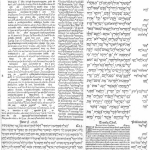
Folks, I had in mind to write a super-interesting post on how the Marshall Plan was an occurrence that was, if not nonrepeatable, than very nearly so, in push-back to the multiple pundits and politicians claiming the solution to whatever problem they have in front of them is a New Marshall Plan (for poor urban areas, for Central America, etc.) — or, alternatively, a “moon shot.” But, as it turns out, the book is overdue at the library so I’ll have to content myself with a few key items I learned.
In the first place, the Marshall Plan was implemented in a context in which Americans fretted not merely about whether reconstruction was proceeding apace but whether Europeans would have enough food to eat. Germans in the American and British sectors (where they were relatively better off) “were living on just 1,550 calories a day, 60 percent of which came from potatoes and bread” (p. 90). Similar statistics held true for France, Britain and elsewhere. There was inadequate electricity to light homes, inadequate coal to heat them, raw materials were missing to operate factories. Germans were struggling to repair their buildings to provide adequate housing, with families in rebuilt buildings allocated 50 square meters per family (about 500 square feet). And Marshall and others knew it would cost a large sum of money, and that this would come from Americans’ pocketbooks (10% of all federal spending in its first year, p. 168), and he directly sought public support (also benefitting from the goodwill he had from the public for his role in the war); it was also important in this respect that Americans as private individuals made their own charitable contributions to European relieve — $789 million in 1946 alone, plus the original CARE packages.
The second striking element Mills describes is the fact that the Marshall Plan was not merely the United States shoveling aid money (or coal or flour) at the Europeans. There was an explicit requirement — the genesis of the EU — that the recipient countries use the money in a coordinated, planned way, and not just each country making plans for its share of the aid money, but that all countries, together, plan its use, with the objective of ensuring a new economic cooperation among these countries. Proposals for “new Marshall Plans” almost entirely envision the plan as consisting solely of money-shoveling, but this second element was crucial. And at this point in time, each of the governments in question was deemed up to the task (though with Germany still having its American occupying force); American “experts” or the postwar equivalent of NGOs were not running the show, except insofar as they made this crucial demand of regional cooperation.
So that’s it. Time to take the book back.
Could the United States ship literal boatloads of money to Central America? Sure. Are there appropriate local governance structures in place? Not according to the promoters of this proposal. Would it make a difference? Maybe, maybe not. But the success of the Marshall Plan in no way indicates whether or not any similar money-shoveling, under wholly-different circumstances, would have the desired effect.












